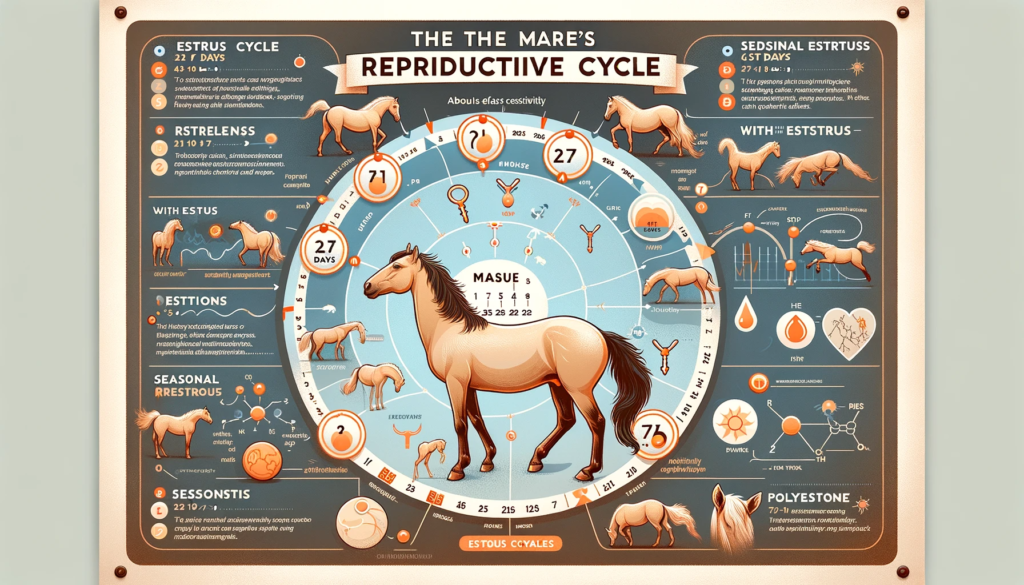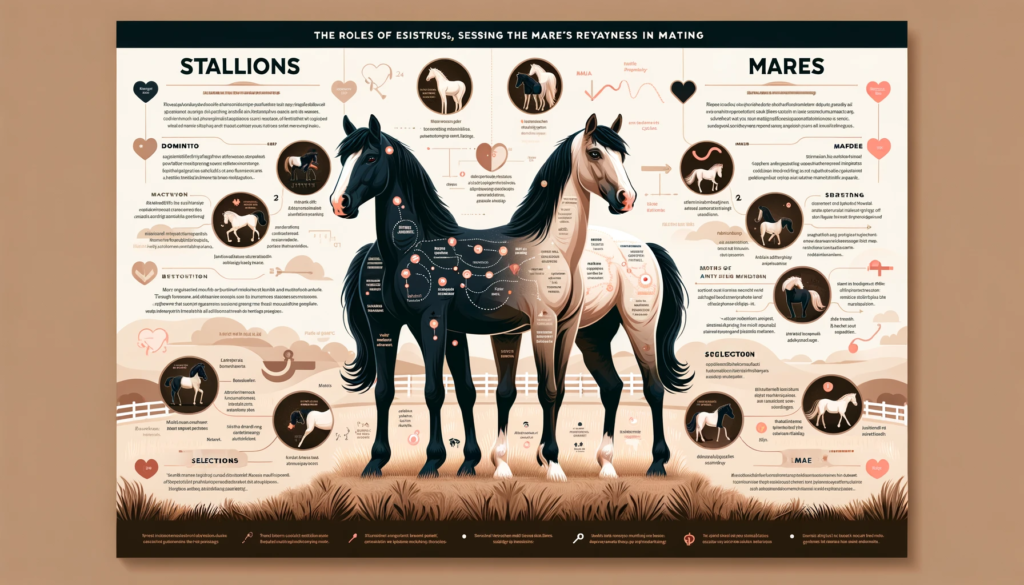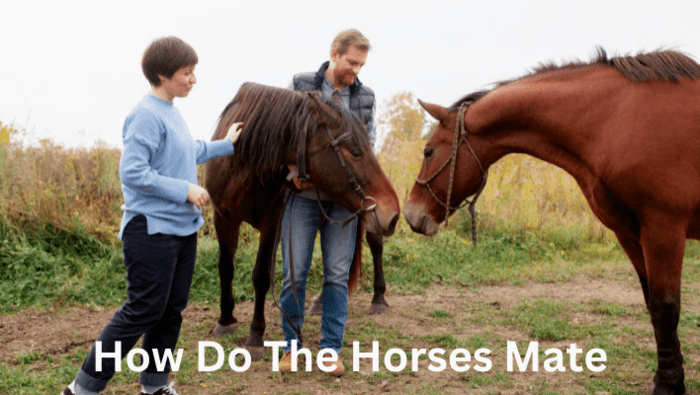Introduction:
Discover the fascinating journey of equine reproduction in our comprehensive guide. From courtship behaviors to the actual mating process, we provide insights into what makes horses unique in their reproductive strategies.
Understand the roles of stallions and mares, and the careful considerations horse breeders must take.
Read More: The Gestation Journey: Exploring Horse Pregnancy Duration

The Courtship Ritual: Understanding Horse Behavior
Horses, like many animals, engage in specific behaviors to initiate and facilitate mating. These courtship rituals are crucial for successful reproduction and vary between individuals. Typically, the stallion exhibits a range of behaviors to show his interest and assess the receptiveness of the mare. These behaviors include:
1.Sniffing and Nuzzling:
The stallion often sniffs the mare, particularly around her genital area, to detect pheromones indicating her readiness to mate.
2.Vocalizations:
Stallions may produce specific sounds, like nickering or whinnying, as part of the courtship.
3.Showcasing Vigor:
Stallions might prance or show off their strength and agility to attract the mare.
Mares, on the other hand, display signs of receptiveness through:
4.Tail Raising:
This allows the stallion to sniff and indicates her readiness.
5.Urination:
Mares in heat may urinate more frequently, which releases pheromones.
6.Flirting Behavior:
Mares might approach and then move away from the stallion, engaging in a kind of flirtatious behavior.
Read More: Exploring the World Through Horse Vision: Key Insights
The Role of the Stallion
The stallion plays a vital role in the horse mating process. His responsibilities extend beyond the physical act of mating:
1.Dominance and Selection:
Stallions often establish dominance to gain access to mares. They may have to compete with other males.
2.Sensing the Mare’s Readiness:
Stallions are adept at detecting pheromones that signal a mare’s reproductive status.
3.Mating Behavior:
Once a mare is receptive, the stallion approaches her for copulation. This process requires careful navigation by the stallion to ensure successful mating without injury to either party.
The Mare’s Reproductive Cycle
Understanding the mare’s reproductive cycle is key in horse breeding:
1.Estrous Cycle:
Mares go through a cycle typically lasting about 21 days, with estrus (the period of receptivity to the stallion) lasting 4-7 days.
2.Seasonal Polyestrous:
Mares are seasonally polyestrous, meaning they have multiple estrous cycles during certain seasons, usually spring and summer.
3.Signs of Estrus:
Visible signs include restlessness, frequent urination, and a swollen vulva. Mares might also show more interest in stallions during this time.
Read More: Horse Lameness: Causes, Diagnosis, & Management

Mating Season: When Horses Breed
Mating season is a critical time in the horse breeding cycle. Horses are seasonally polyestrous creatures, meaning they have multiple estrous cycles during certain seasons. This usually happens in the warmer months, typically from late spring to early autumn. The exact timing can vary based on geographic location and environmental factors.
1.During the mating season:
Longer Daylight Hours:
Increased daylight triggers hormonal changes in horses, making them ready for breeding.
Stallion Behavior:
Stallions become more active and show increased interest in mares.
Mare Readiness:
Mares enter their estrous cycle, indicating their readiness to mate.
Natural Mating vs. Assisted Reproduction
The process of horse breeding can be divided into two main categories: natural mating and assisted reproduction.
1.Natural Mating:
In natural mating, the stallion and mare are physically brought together for copulation.
This method relies heavily on the natural behaviors and instincts of the horses.
Risks include potential injury to either horse and the transmission of diseases.
2.Assisted Reproduction:
Techniques like artificial insemination (AI), embryo transfer, and in vitro fertilization are used.
AI is particularly popular as it allows the use of a stallion’s semen without the need for physical mating, reducing the risk of injury and disease transmission.
These methods also enable breeders to overcome fertility issues and preserve valuable genetic lines.
Read More: Fastest Horse in the World: A Gallop Through Time and Records
Pregnancy Confirmation and Mare Care
After mating or artificial insemination, confirming pregnancy in the mare is essential. This is usually done through:
1.Palpation:
A veterinarian can often feel the developing fetus by palpating the mare’s abdomen.
2.Ultrasound:
This provides a visual confirmation of pregnancy and is used to monitor the fetus’s development.
3.Hormone Testing:
Blood tests can detect hormones associated with pregnancy.
4.Once pregnancy is confirmed, mare care becomes paramount:
Nutrition:
Mares require a well-balanced diet with adequate nutrients to support both themselves and the developing foetus.
Exercise:
Regular, moderate exercise is beneficial, but strenuous activities should be avoided, especially as the pregnancy progresses.
Health Monitoring:
Regular check-ups by a veterinarian are essential to monitor the health of the mare and the unborn foal.
Environment:
Providing a safe, stress-free environment is crucial for the mare’s well-being during pregnancy.
Read More: Where Do Horses Come From: A Journey Through Equine Origins
Managing the Breeding Environment
The environment in which horses mate is crucial for their safety and the success of the breeding process. Key elements in managing the breeding environment include:
1.Safety:
Ensuring a safe, controlled area for mating is crucial to prevent injuries to the horses. This includes having enough space, secure fencing, and a non-slip surface.
2.Stress Reduction:
A calm, quiet environment helps reduce stress for both the stallion and mare, which can impact the success of mating.
3.Health Considerations:
The breeding area should be clean and free from contaminants that could cause infections or health issues.
4.Controlled Access:
Managing access to the breeding area prevents unnecessary disturbances and maintains the focus of the breeding pair.
Common Challenges in Horse Mating
Several challenges can arise during the horse mating process:
1.Behavioral Issues:
Aggression or lack of interest from either the stallion or mare can hinder successful mating.
2.Physical Problems:
Fertility issues in either the mare or stallion can prevent conception.
3.Health Risks:
The transmission of sexually transmitted diseases or injuries during mating are potential risks.
4.Environmental Factors:
Poor weather, inadequate facilities, or other environmental stressors can negatively impact the mating process.
Read More: Exploring Careers with Horses: What Jobs Involve Horses?

Ethical Considerations in Horse Breeding
Ethical breeding practices are essential in horse reproduction:
1.Welfare of the Horses:
Ensuring the physical and psychological well-being of the horses is paramount.
2.Breeding for Quality, Not Quantity:
Responsible breeders focus on improving the breed, not just producing as many foals as possible.
3.Genetic Diversity:
Avoiding inbreeding and ensuring genetic diversity is crucial for the health and sustainability of the breed.
4.Retirement and Aftercare:
Providing for the long-term welfare of the breeding horses after their reproductive years is an ethical responsibility.
Read More: Are Horses Ruminants? Understanding Equine Digestion
The Future of Equine Reproduction
Advancements in science and technology are shaping the future of equine reproduction:
1.Genetic Technologies:
Innovations like gene editing and genomic selection could enable breeders to select for desirable traits more effectively.
2.Advanced Reproductive Techniques:
Improvements in artificial insemination, embryo transfer, and in vitro fertilization are expanding breeding possibilities.
3.Health and Disease Management:
Emerging research in equine health could lead to better management of reproductive diseases and overall health in breeding horses.
4.Sustainability and Welfare Focus:
An increasing focus on sustainability and welfare in breeding practices is likely to drive future approaches to equine reproduction.
Innovative Strategies in Horse Breeding: Blending Tradition with Technology
In the realm of horse breeding, a fascinating synergy between time-honored traditions and technological advancements is unfolding. This blend not only enhances genetic diversity and improves breeding outcomes but also ensures the health and welfare of the horses involved.
1.Genomic Selection and Genetic Analysis:
Modern horse breeding increasingly employs genomic selection, a process that utilizes DNA analysis to identify desirable genetic traits. This approach enables breeders to make more informed decisions, aiming to enhance specific characteristics like speed, endurance, or even disease resistance in future generations.
2.Telemetric Monitoring in Breeding Horses:
The use of wearable technology, such as telemetric monitors, has become more prevalent in monitoring the health and fitness of breeding horses. These devices provide real-time data on heart rate, movement, and overall well-being, allowing for more precise and proactive management of horses’ health.
3.Artificial Intelligence in Selective Breeding:
AI algorithms are being developed to analyze vast amounts of data, including lineage, health records, and even behavioral patterns, to predict the best breeding matches. This not only maximizes the genetic potential but also reduces the risk of hereditary diseases.
4.Remote Breeding Consultations and Digital Platforms:
With the advent of digital communication platforms, remote consultations with veterinary experts and breeding specialists have become possible. This innovation is especially beneficial for breeders in remote or underserved areas, providing access to expert advice and guidance.
5.Sustainable Breeding Practices:
Technology is also playing a role in promoting sustainability in horse breeding. From environmentally friendly farm management systems to the development of feeds that optimize nutrition while minimizing environmental impact, breeders are increasingly adopting practices that are both effective and ecologically responsible.
6.Ethical Considerations and Transparency:
The integration of technology in horse breeding also brings a new level of transparency and ethical considerations. Breeders can now track and share the lineage and medical history of their horses more efficiently, promoting responsible breeding practices and animal welfare.
Conclusion:
Horse mating is a complex process that involves much more than the physical act of reproduction. It encompasses a range of behaviors, environmental factors, and ethical considerations.
Understanding these aspects can help in the responsible and effective breeding of these majestic animals.
FAQs:
How long is a horse’s gestation period?
The typical gestation period for a horse is approximately 11 months.
Can horses mate at any time of the year?
Horses have a seasonal mating pattern, typically in the spring and summer.
What is artificial insemination in horses?
A technique used in horse breeding where semen is collected and manually inserted into the mare.
How can you tell if a mare is in heat?
Mares in heat may show signs like restlessness, frequent urination, and interest in stallions.
What are some common problems during horse mating?
Issues can include lack of interest, aggression, or physical incompatibility.
